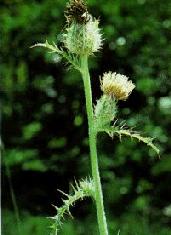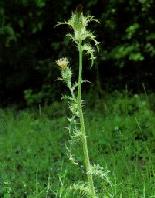
Edible Thistle
Cirsium edule Nutt.

Edible Thistle
Cirsium edule Nutt.
The stems are variable, from very short up to over 6 feet tall. The leaves are usually lobed with the teeth and lobes ending in spines or at least the tip ending in spines. The flowers are clustered in spiny, burr like heads; usually white or pink, or reddish is color. They are widespread throughout the Rocky Mountain area ranging form lower elevations to above the timberline.
Food Use: The root is likely to be rich in inulin, a starch that cannot be digested by humans. This starch thus passes straight through the digestive system and, in some people, ferments to produce. Young stems may be peeled and eaten raw. Soft and sweet, they are considered to be a luxury food. Young shoots, also may be raw or cooked as greens. Meriwether Lewis wrote about the Edible Thistle. "The root of the Thistle, when first taken from the earth, is white and nearly as crisp as a carrot; when prepared for use, it becomes black, and is more sugrary than any fruit or root that I have met with in use among the natives."
Other Uses. The seed of all species of thistles yields a good oil by expression..Planting An easily grown plant, succeeding in any ordinary garden soil in a sunny position. It grows for a number of years without flowering, but then dies after flowering.
